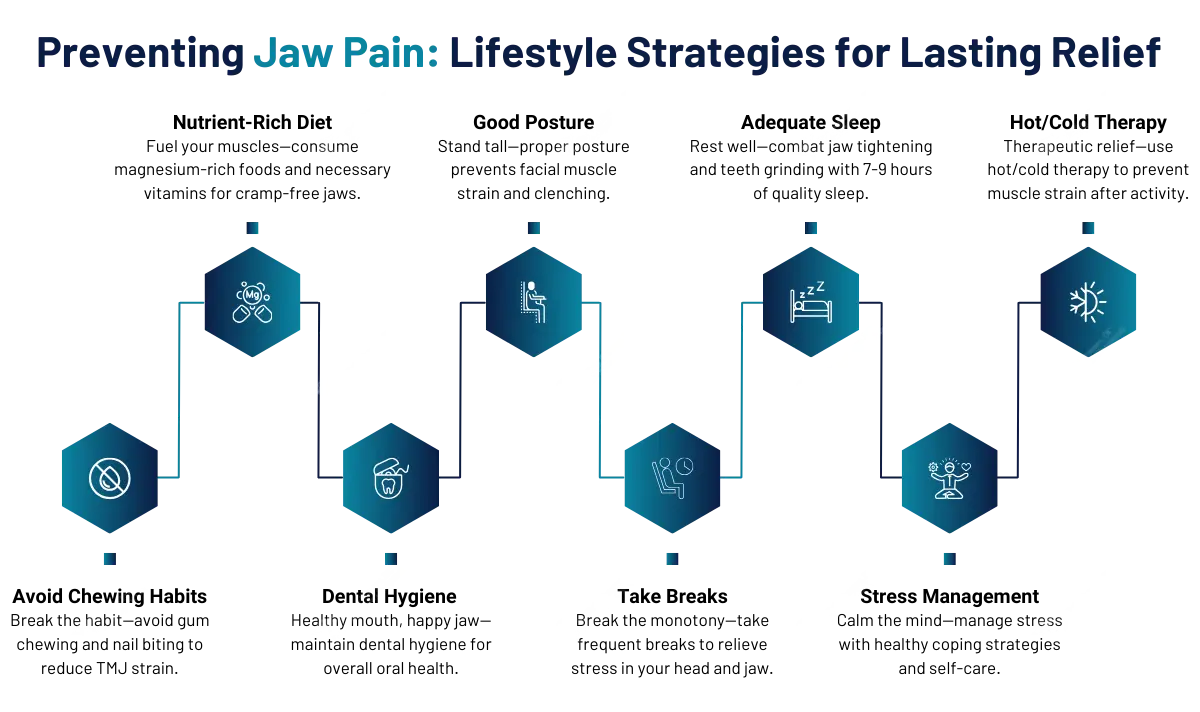If you’ve ever experienced jaw pain, stiffness, or discomfort when chewing or opening your mouth, you may have temporomandibular joint (TMJ) disorder.
In the United States, 5-12% of people experience TMJ pain, which can have a substantial impact on their everyday lives. Jaw pain not only makes eating difficult but can also trigger headaches, earaches, and neck pain.
While medication or surgery may sometimes be necessary, there are drug-free, non-invasive treatment options like chiropractic care that can effectively relieve TMJ discomfort.
Keep reading to learn how chiropractic adjustments can help reduce jaw pain and improve function.
What is Jaw Pain?
- Make it uncomfortable to open your mouth wide
- Cause trouble chewing or swallowing food
- Make your jaw feel stiff or like it is stuck
- Cause sharp pains when you bite down
- Give you a headache or sore neck
- Make loud clicking or popping sounds
Understanding the TMJ
The temporomandibular joint (TMJ) joins the bottom jaw (mandible) and skull. You may suffer from TMJ on either side of your face. These joints help you to move your mouth while chewing, speaking, yawning, or swallowing.
TMJ problems are a very common reason for jaw pain on just one side. The medical term for this is temporomandibular joint disorder. TMD causes the joints not to work smoothly. It leads to pain and limited movement.
Causes of Jaw Pain on One Side
There are several potential sources of discomfort in the jaw on one side of the face. These include,
Temporomandibular Joint Disorder
- Injury: Getting hit in the jaw can damage the soft tissues.
- Arthritis: Osteoarthritis can develop in the TMJ.
- Disk Issues: The rubbery disk in the joint moves out of place.
- Stress: Clenching due to anxiety tightens the muscles.
2. Teeth Grinding
Bruxism is defined as grinding or locking one’s teeth. Many people crush their teeth without realizing it, particularly during sleep.
Grinding puts too much pressure on the chewing muscles and TMJ. It can inflame the joint on one side. Using a mouthguard while sleeping can help prevent bruxism. But chronic teeth grinding can permanently damage the jaw joint.
3. Dental Problems
- Losing a tooth
- Getting a cavity
- Having a cracked or broken tooth
- Having an infection or abscess
- Getting wisdom teeth
- Needing braces
4. Injury to the Jaw
- Sports impacts
- Falls
- Vehicle accidents
- Physical violence
5. Other Causes
- Sinus infections: This causes pain in the upper teeth.
- Ear infections: These can make the jaw joint ache.
- Trigeminal neuralgia: Nerve damage creates stabbing cheek pains.

Symptoms and Diagnosis
- Pain that is worse when chewing
- Jaw stiffness or trouble opening your mouth
- Clicking, popping, or grinding noises when you move your jaw
- Headaches or neck pain
- An uneven bite
- Swelling around the jaw joint
- Feeling like your teeth don’t fit right
Medical Treatments
- Pain relievers: Over-the-counter meds like ibuprofen can ease soreness.
- Heat/ice packs: Hot or cold compresses help swelling and tension.
- Jaw rest: Not moving gives the structures time to heal.
- Cortisone injections: These shots reduce inflammation.
- Medications: Muscle relaxants loosen up tight chewing muscles.
- Surgery: This repairs damaged joints or realigns the bite.

Chiropractic Treatment for Jaw Pain
Seeing a chiropractor can also help ease jaw pain on one side. Though you may not think your spine is related to your face, misalignments in the neck can strain the jaw joint and muscles. Our chiropractor uses specialized protocols to realign the upper back and neck to alleviate this tension.
1. Spinal Realignment
Our chiropractor may perform precise joint manipulation and mobilization techniques to restore the alignment of the upper cervical vertebrae and base of the skull. These bony segments protect the primary nerves that control chewing, biting, and facial muscle movement.
Misalignments here increase pressure on these nerves, causing referred pain in the face and jaw area even if the spine feels fine. Releasing tight muscles and realigning specific vertebrae takes pressure off the nerves, decreasing inflammation and pain signals to give your face lasting relief.
2. Physical Therapy Techniques
Additional supportive care includes soft tissue work, stretches, and heat therapy. Our chiropractor may massage tense muscles in the shoulders, neck, and jaw to relax muscle knots pulling on sore joints.
Custom exercises will stretch tight ligaments, contributing to misalignments, while moist heat loosens up injured tissues. This multifaceted physical therapy approach facilitates healing alongside the main spinal adjustments.
3. Instrument-Assisted Soft Tissue Mobilization
Special instruments break up the scar tissue and adhesions that build up in injured chewing musculature. It disrupts the chronic inflammation, causing persistent muscular pain. It also restores proper tissue mobility for smooth joint function. Increased blood flow to the strained areas further accelerates natural healing.
4. Focused Shockwave Therapy
Non-invasive shock wave treatment produces healing micro-trauma deep within chronically damaged jaw tissues. The acoustic sound wave pulses stimulate accelerated repair of degenerated joint structures and feed oxygenated blood to deprived muscles.
Eliminating the underlying tissue dysfunction provides lasting relief when other conservative efforts fail to resolve pain. If jaw pain persists despite home care, include a chiropractor as part of your treatment team. Spinal adjustments combined with lifestyle changes give significant relief.

Want to address your jaw pain without drugs and invasive procedures?
Give our chiropractic services a try. We will evaluate your jaw and guide you if you can benefit from it.
Get AppointmentPrevention Strategies
- Avoid Chewing Gum or Nail Biting: The continual swallowing motion strains the TMJ. Stop if you find yourself grinding or locking your teeth.
- Get Enough Magnesium and Vitamins: Lack of nutrients causes muscle cramps and spasms. Eat magnesium-rich foods like almonds, spinach, and avocado. Take vitamins as required.
- Maintain Proper Dental Hygiene: Brush gently two times a day and floss once every day. Every six months, see your dental professional for a cleaning. It keeps your mouth healthy and prevents dental pain.
- Use Good Posture: Slouching strains facial muscles. Keep your spine aligned to avoid clenching related to sore necks and backs.
- Take Frequent Breaks: Set a timer if you spend all day on the web or doing other activities that take focus. Every 30-60 minutes, stand up and move about to relieve stress in your head and jaw.
- Get Enough Sleep: Fatigue causes jaw tightening and teeth grinding at night. Strive to get between seven and nine hours of sleep per night. Consider a mouth guard if you still clench your teeth when resting.
- Manage Your Stress: Finding healthy coping strategies prevents clenching due to anxiety. Do relaxing hobbies, get counseling if needed, or take time for self-care.
- Use Hot/Cold Therapy Preventatively: Apply warm compresses or ice packs to tight jaw muscles after exercise or a long day. It prevents strain from building up.

The Final Words
Jaw pain confined to just one side can negatively impact your quality of life. Understanding common sources of discomfort helps you identify why your face may hurt occasionally.
Getting enough rest, minimizing jaw strain, practicing stress-relieving habits, and using heat/ice therapy help symptoms resolve quicker. Pay attention to any worsening or persistent one-sided pain, which indicates the need for medical care.
Addressing jaw discomfort prevents minor issues from spiraling into chronic conditions. Most cases of jaw soreness can be cured with proper treatment, so you can get back to pain-free eating, smiling, and living!

Meet Dr. Craig Eymann, a dedicated chiropractor and yoga enthusiast with over two decades of expertise in spinal health, sports chiropractic, and personalized care, prioritizing misalignment correction for swift injury resolution.
Categories
Tags
Recent Blogs
Are you suffering from TMJ pain, too?
Book an appointment with our Chiropractor and get pain relief first-hand.
Get Appointment


Leave A Comment